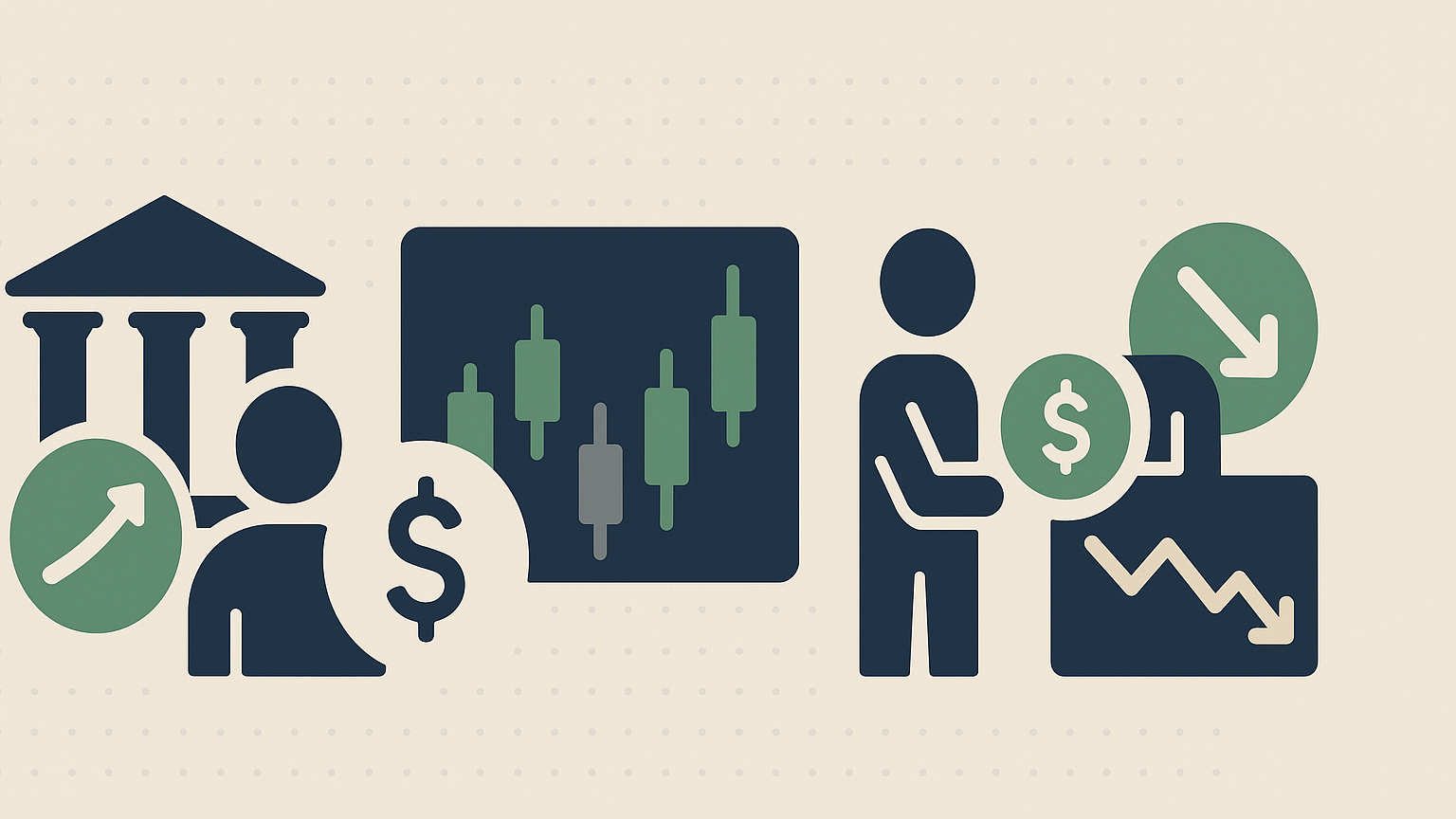Learn the essentials of options trading, from key concepts to risk management strategies, and start trading with confidence.
Options trading can help you profit in rising, falling, or even flat markets while managing risks and using less capital than buying stocks outright.
Here’s what you’ll learn in this guide:
- What Are Options? Contracts that give you the right (not obligation) to buy or sell an asset at a set price before a certain date.
- Key Terms: Strike price, premium, expiration date, and underlying asset.
- Why Trade Options? Flexibility, portfolio protection, and income generation.
- How Are Options Priced? Factors like stock price, time decay, volatility, and interest rates impact premiums.
- Beginner Strategies: Buying calls and puts, writing covered calls, and selling cash-secured puts.
- Risk Management: Position sizing, avoiding overtrading, and managing volatility.
- Helpful Tools: Platforms like TradingView and LuxAlgo simplify analysis and execution.
Options trading is versatile but requires a solid understanding of pricing, strategies, and risk management. Let’s dive into the details to help you get started confidently.
Options Trading for Beginners in 10 Minutes
Options Pricing and Structure
Understanding how options are priced is crucial for traders aiming to make sound decisions. Below, we break down the main components and factors that influence an option's market value, covering premium components, pricing factors, and the Greeks.
Option Premium Components
An option's premium consists of two parts: intrinsic value and time value. For instance, in Q4 2024, when GE Aerospace (GE) shares were trading at $187.40, the intrinsic value of a GE 180 call option was $7.32 per share. This was calculated as:
$187.40 – $180 – $0.08.
The time value is simply the premium minus this intrinsic value.
Keep in mind: Options lose about one-third of their value during the first half of their lifespan and two-thirds in the second half.
Price Impact Factors
Several variables influence an option's price:
| Factor | Impact on Premium | Example |
|---|---|---|
| Stock Price Movement | Direct relationship: higher stock price = higher call premium | A rising stock price increases call premiums. |
| Time to Expiration | Premium declines as expiration nears | Premiums fall faster during the final weeks. |
| Interest Rates | Calls benefit, puts decline as rates rise | Higher rates favor call options, hurt put options. |
| Implied Volatility | Higher volatility increases premiums | Greater market uncertainty raises option costs. |
These factors work alongside the Greeks, which provide deeper insights into an option's risk profile.
The Greeks in Options
The Greeks are tools to measure how an option's price reacts to market changes. Each one focuses on a specific type of risk:
| Greek | What It Measures | Key Detail |
|---|---|---|
| Delta | Sensitivity to changes in the underlying asset | Ranges from -100 to 0 for puts and 0 to 100 for calls. |
| Gamma | Rate of change for Delta | Highest for at-the-money options. |
| Theta | Impact of time decay | Always negative. |
| Vega | Sensitivity to changes in volatility | Reflects a ~$1 change per 1% shift in volatility. |
"For an options trader, the greeks are the key to the trading strategy." – Doug Ashburn
Think of Delta as the "speed" of price changes and Gamma as the "acceleration." These metrics help refine risk assessments and guide trading strategies.
Simple Options Trading Methods
Here are three straightforward options trading strategies that can help you get started with confidence. By applying basic pricing concepts and understanding risks, these methods make it easier to put theory into practice.
Buying Calls and Puts
One of the simplest ways to begin trading options is by buying calls or puts. Buying a call means you profit if the stock price goes up, while purchasing a put benefits you if the stock price drops.
"You can use options to speculate and to gamble, but the reality is ... the best use of options is to protect your downside".
| Strategy | Best For | Risk Level | Maximum Loss |
|---|---|---|---|
| Call Buying | Expecting prices to rise | Moderate | Limited to the premium paid |
| Put Buying | Expecting prices to fall | Moderate | Limited to the premium paid |
| Both Types | Uncertain, volatile markets | Varies | Premium paid per contract |
Writing Covered Calls
A covered call strategy involves selling call options on stocks you already own. This can help generate extra income while still holding onto your shares.
"A covered call is a popular options strategy used to generate income for investors who think stock prices are unlikely to rise much further in the near term".
Example: If you own 100 shares of XYZ stock priced at $50 per share, you could sell a six‐month call option with a $55 strike price for a $4 premium. This would bring in $400 immediately, allow for a potential sale at $55, and reduce your losses by the premium received. In this scenario, your maximum return could reach 18% over six months.
Selling Cash-Secured Puts
Cash-secured puts are another way to approach options trading. This method allows you to earn income while potentially buying stocks at a discount.
Key requirements for cash-secured puts:
- Have enough cash available to purchase 100 shares at the strike price.
- Focus on stocks you’re interested in owning.
On platforms like Public, rebates range from $0.06 to $0.18 per contract, depending on your monthly trading volume.
Up next, dive into risk management techniques to make these strategies even more effective.
Managing Risk in Options
To succeed with options trading, you need a disciplined approach to managing risk. By protecting your capital, you set the stage for consistent returns. Here are some strategies to keep your risk in check.
Trade Size and Money Management
Sizing your trades correctly is key to staying in the game long-term. A cautious approach helps safeguard your capital while giving you room to grow.
| Risk Level | Portfolio Allocation per Trade | Maximum Position Size |
|---|---|---|
| Conservative | 1% | $1,000 on a $100,000 account |
| Moderate | 2% | $2,000 on a $100,000 account |
| Aggressive | 3-5% | $3,000–$5,000 on a $100,000 account |
Adjust your position sizes based on your account size and how much risk you’re comfortable taking. For example, if you’re buying a $1,000 call option, limit your potential loss to $500.
Trading Frequency and Leverage Limits
Overtrading and using too much leverage can quickly lead to losses. To avoid these pitfalls:
- Stick to strategies with defined risk.
- Trade only when the market is stable.
- Wait for clear and reliable setups.
- Keep your position sizes consistent.
Tools like the InsiderFinance Options Profit Calculator can help you estimate potential profits and losses, making it easier to plan your exits. Setting these boundaries ensures your trading stays grounded in a solid risk management plan.
Volatility Effects on Options
Market volatility plays a big role in determining option prices. Implied volatility (IV) reflects how much the market expects the underlying asset’s price to fluctuate during the option’s lifespan. The CBOE Volatility Index (VIX) is a popular tool for gauging market sentiment and risk.
Here’s how to handle volatility risk:
- Keep an eye on IV levels before entering trades.
- Use smaller positions during highly volatile times.
- Try strategies like iron condors or short straddles when volatility is elevated.
- Protect yourself with strategies like covered calls.
Options are highly sensitive to changes in the underlying asset's price. Even small price shifts can lead to major changes in an option's value. That’s why proper position sizing and careful risk management are non-negotiable for lasting success.
Options Trading Software
Using software tools can make options trading more efficient by offering detailed analytics, fast execution, and helpful learning resources.
LuxAlgo Trading & Analysis Features
LuxAlgo provides hundreds of free indicators along with exclusive trading features on TradingView, including:
- Automatic pattern detection and volumetric order blocks to pinpoint entry and exit opportunities.
- Real-time signal overlays to highlight emerging market trends.
- AI-driven backtesting to assist in refining strategies over multiple timeframes.
The Essential plan ($24.99/month) offers basic price action tools and screener functionality, while the Ultimate plan ($59.99/month) includes access to the AI backtesting assistant for advanced strategy development.
TradingView for Options Analysis

TradingView is a popular platform used by millions of traders worldwide. It combines a user-friendly interface with powerful charting tools, live market data, and a paper trading feature.
"TradingView is an excellent platform for beginners." – Zeiierman
They offer a range of subscription plans, from a free version with basic features to the Premium plan at $59.95/month.
Trading Communities and Broker Platforms
Many brokers and trading platforms include active communities where traders can share insights and strategies. Here’s a quick overview of some popular choices:
- Interactive Brokers, tastytrade, and E*TRADE: Charge $0.15–$1 per contract and provide in-depth analytical tools.
- Webull: Offers commission-free trading and an easy-to-use mobile app.
Both Interactive Brokers and Webull have earned strong ratings of 4.5/5 for their respective features.
These platforms can help you implement the risk-managed strategies mentioned earlier. Up next, learn how to align these tools with your overall trading approach.
Summary and Next Steps
Now that we've gone over pricing, strategies, and risk management, let's recap the key points and outline how to get started with options trading.
Key Takeaways
- Options contracts allow you to buy or sell a specific security at a set price before a certain date.
- Pricing depends on factors like time decay, market volatility, and overall conditions.
- Managing risk effectively is crucial - this includes proper position sizing, limiting leverage, and choosing trades wisely.
- Using technical tools and trading platforms can help you analyze opportunities and execute trades with more precision.
With these basics in mind, here are some practical steps to kick off your options trading journey.
Starting Your Options Trading Journey
-
Begin with Education
Practice with paper trading on platforms like Moomoo to refine your strategies and observe price movements. -
Open an Account
Choose a broker that aligns with your trading style and offers helpful educational tools. -
Develop Your Strategy
Start with straightforward strategies that match your experience level, such as:- Covered calls for income generation
- Protective puts for minimizing downside risk
- Cash-secured puts for acquiring stocks at favorable prices
| Trading Level | Approach | Risk Profile |
|---|---|---|
| Beginner | Paper trading | No real money risk |
| Intermediate | Covered calls, protective puts | Limited risk exposure |
| Advanced | Multi-leg strategies | Requires active management |
References
- TradingView – Advanced charting and analysis platform.
- Investopedia: Options Basics – A comprehensive guide to options trading.
- CBOE Volatility Index (VIX) – Essential insights into market volatility.
- LuxAlgo – Innovative trading solutions on TradingView.






